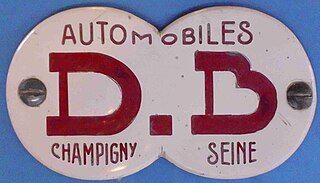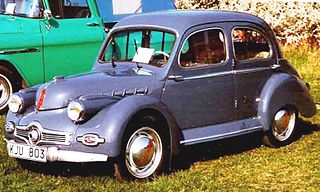
Deutsch-Bonnet (DB), is a brand of sports cars created in 1937 by Charles Deutsch and René Bonnet and disappeared in 1962.

Chappe et Gessalin is the short-form of the name of French coachbuilder "Carrosserie Chappe Frères et Gessalin". The company built automobile bodies and did contract assembly for other automobile manufacturers. It was also the parent of Automobiles CG, a French automobile maker founded in 1966 which built and sold complete cars under its own name.

Panhard was a French motor vehicle manufacturer that began as one of the first makers of automobiles. It was a manufacturer of light tactical and military vehicles. Its final incarnation, now owned by Renault Trucks Defense, was formed by the acquisition of Panhard by Auverland in 2005, and then by Renault in 2012. In 2018 Renault Trucks Defense, ACMAT and Panhard combined under a single brand, Arquus.

The Renault 4, or R4 in short, is an economy car built by the French company Renault from 1961 to 1994. Although the Renault 4 was first marketed as a short estate or wagon, its minimal rear overhang, and its top-hinged, single-piece tail-gate made it the world's first mass-produced hatchback car, as well as the first time Renault had used a front-wheel-drive layout in a family car. A bare-bones, entry-level Renault 3, or R3 was also offered in 1961/1962.
Berliet was a French manufacturer of automobiles, buses, trucks and military vehicles among other vehicles based in Vénissieux, outside of Lyon, France. Founded in 1899, and apart from a five-year period from 1944 to 1949 when it was put into 'administration sequestre' it was in private ownership until 1967 when it then became part of Citroën, and subsequently acquired by Renault in 1974 and merged with Saviem into a new Renault Trucks company in 1978. The Berliet marque was phased out by 1980.

The Renault 4CV is a car produced by the French company Renault from August 1947 through July 1961. It is a four-door economy car with its engine mounted in the rear and driving the rear wheels. It was the first French car to sell over a million units, and was superseded by the Dauphine.

The Renault Juvaquatre is a small family car / compact car automobile produced by the French manufacturer Renault between 1937 and 1960, although production stopped or slowed to a trickle during the war years. The Juvaquatre was produced as a sedan/saloon until 1948 when the plant switched its full attention to the new Renault 4CV. During the second half of 1952 the plant restarted production of the Juvaquatre sedans/saloons for a period of approximately five months.

The Renault Caravelle is a sports car manufactured and marketed by Renault for model years 1958–1968 in a single generation — as a rear-engine, rear-drive open two/four-seater designed by Pietro Frua of Carrozzeria Ghia, using the floorpan and engine of the Renault Dauphine.

The Panhard PL 17 is an automobile made by the French manufacturer Panhard from 1959 until 1965. Presented on 29 June 1959, as successor to the Panhard Dyna Z, the PL 17 was essentially a facelifted version of its predecessor. The initial four-door saloon was joined by the Cabriolet in 1961, and by the Break, a five-door estate version, in April 1963. The Break, developed by Italian company Pan Auto, sat on a longer wheelbase but was of the same overall length.

Devin Enterprises was an American automotive manufacturer that operated from 1955 to 1964. Devin was mainly known for producing high quality fiberglass car bodies that were sold as kits, but they also produced automotive accessories as well as complete automobiles. The company was founded by Bill Devin.

The Panhard Dyna X was a lightweight berline designed by the engineer Jean Albert Grégoire and first exhibited as the AFG (Aluminium Français Grégoire) Dyna at the Paris Motor Show in 1946.
Autobleu was a French automotive parts manufacturer based in Paris. They produced a variety of components, but were best known for their intake and exhaust manifolds. They also built a small number of customized cars based on models from larger manufacturers.

The Alpine A106 is a sports car that was the first of a line of light-weight glass-fibre bodied, rear-engined two-door coupés produced for a young competition-oriented Dieppe based Renault dealer called Jean Rédélé. The car was based on mechanical components from the Renault 4CV.

The HBR 5 model (1954–1959) was Deutsch and Bonnet's (DB) most successful project to date, with several hundred of the cars produced until 1959. Another small series of lowered and lightened cars called "Super Rallye" occurred in 1960 and 1961. Around 660 of the Mille Miles, Coach, and HBR 4/5s were built in total. Other sources account for 950 DB coupés, of which nearly all would be HBRs and their Frua-designed predecessors.
The SOciété des Véhicules André Morin (SOVAM) is a French company that specializes in mechanized handling equipment for airports. In the mid-to-late 1960s they also operated an automobile manufacturing division that enjoyed a modicum of success but that was never profitable.

The Renault Vivasport was a 6-cylinder engined executive automobile introduced by Renault in September 1933 and produced till April 1935. A larger engined version was produced between December 1934 and February 1938. As with many Renaults during the 1930s, type changes as well as small often cosmetic facelifts and upgrades appeared frequently.
Jacques Durand was a French engineer, model builder and automobile designer. He is primarily known for designing several sports cars, which were built in small volumes in France beginning in the 1950s and continuing into the 1990s.

The Panhard CD is a car designed by Charles Deutsch and built by Panhard from 1963 to 1965. The CD was named for Deutsch and is considered a continuation of the line of Panhard-powered vehicles built by Deutsch-Bonnet. The car was the production version of the CD Dyna that raced at Le Mans in June 1962.

The Sera is a small sports car built in France from 1959 to 1961. A few cars were also built in Spain.
Pichon-Parat was a French carrosserie based in the commune of Sens, in the department of Yonne. Established in 1952, it was known for producing custom cabriolet, coupé, estate car, and shooting brake conversions of established models from major automakers, and for building their own distinctive sporting models with completely original bodywork.















